Stevia is well known as an all-natural sweetener, but did you know you can grow it right in your home garden?
Growing stevia is actually simple once you learn what it needs to thrive and how to care for it. This guide is designed to help you do just that.
Here you will find everything you need to start growing stevia. From the right soil, temperature, fertilizer, and light exposure to how to water, prune, harvest, troubleshoot problems, and much more.
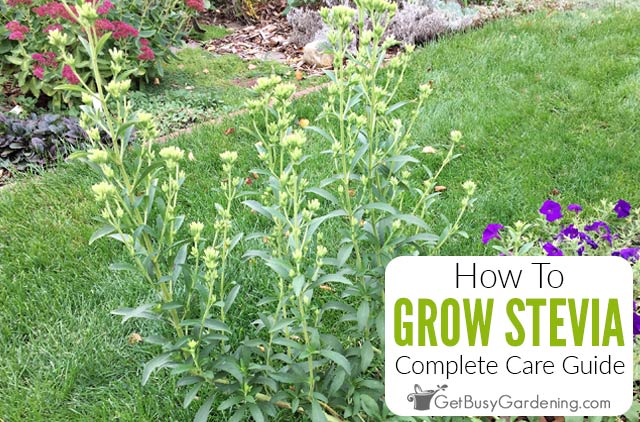
Quick Stevia Plant Care Overview
| Scientific name: | Stevia rebaudiana |
| Classification: | Herb |
| Common names: | Stevia, Green Stevia, Sweet Herb, Sweetleaf |
| Hardiness: | Zones 8-11 |
| Temperature: | 70-85°F (21-29°C) |
| Flowers: | White, blooms late summer-fall |
| Light: | Full sun to dappled shade |
| Water: | Keep soil evenly moist, never allow it to dry completely |
| Humidity: | Average-high |
| Fertilizer: | Compost tea or fish emulsion, summer |
| Soil: | Loamy, loose, well-drained |
| Common pests: | Thrips, aphids, whiteflies, snails, slugs |
Information About Stevia Plants
Stevia (Stevia rebaudiana) is a tropical perennial herb in the daisy, or Asteraceae family, native to Brazil and Paraguay. It’s grown for the leaves that are up to 40 times sweeter than sugar.
The ovate serrated leaves grow on brittle branches and can be used fresh, dried, or ground. They taste similar to a sweet green tea with a mild licorice finish.
The plant is often called “green stevia”, “sweet herb”, or “sweetleaf” to differentiate the natural herb from the refined store-bought stevia products.
In the late summer or fall delicate, small white flowers form at the end of the branches.
Hardiness
Stevia is not a cold hardy plant, it prefers warmth. It can survive year round in zones 8-11 where it can flourish during long growing seasons and survive the mild winters.
Though it’s a perennial, the leaves lose sweetness with each year. So many gardeners, even in warm climates, choose to grow it as an annual instead.
How Does Stevia Grow?
Green stevia is a flowering herb that can be grown from seed or cuttings. It produces bright green leaves with an intense sweetness.
The leaves grow in symmetrical pairs on spindly, brittle stems. The branches can grow up to 36” in ideal conditions, but can also be pruned into a bushier, mounded plant.
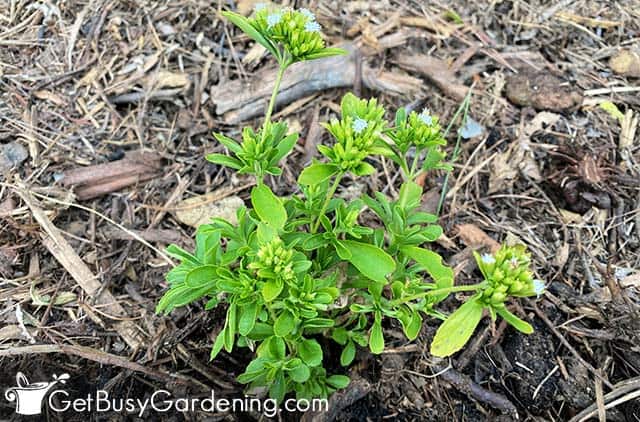
How To Grow Stevia
Before we talk about how to take care of it, first we need to chat about where and when to grow stevia. The right timing and location will make a big difference in your success.
Where To Grow Stevia
Stevia likes a spot with plenty of warmth, light, and humidity. It won’t do well in excess heat, the cold, or very dry climates.
It can be grown in fertile, well-draining soil in the garden, containers, or even indoors. Pots need to be at least 12” deep and have drainage holes to prevent overwatering.
When To Plant Stevia
You can start Stevia rebaudiana indoors 6-8 weeks before the last spring frost, or direct sow it 2 weeks after.
The seeds can be tricky to germinate, so many gardeners choose to use nursery starts or cuttings taken from a previous year.
Transplant hardened rooted cuttings or starts into the garden when all chance of frost has passed in the spring.
The soil should be 70°F (21°C), which you can check with a simple probe gauge, and night temps consistently above 60°F (15°C).
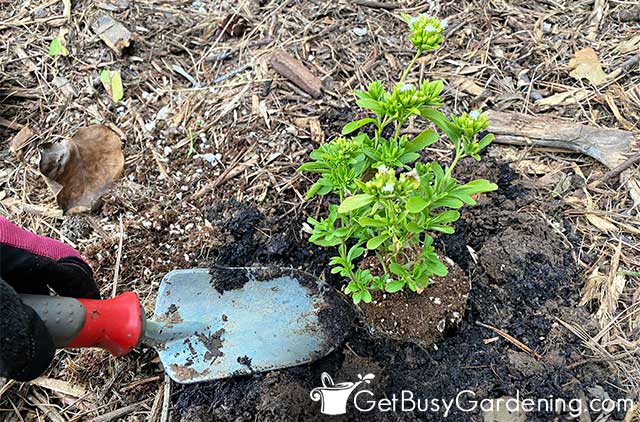
Stevia Plant Care & Growing Instructions
Now that you know where and when to get started, let’s talk about how to grow stevia. The care tips below will help you create the best environment for it to thrive.
Sunlight
Stevia thrives in a full sun location that will provide 8+ hours of light a day. Lack of sunlight can delay or stall growth or cause leggy, sparse foliage, especially indoors.
However in very overly warm or arid climates, provide dappled shade during the hottest afternoon hours. That will prevent drying out and premature flowering. A shade cloth makes this easy.
Water
In its native environment stevia grows in damp soil near ponds and other bodies of water.
It will thrive in your garden if kept consistently and evenly moist. Do not let the soil dry out completely between watering.
Always water at the soil line to prevent splashing it on the leaves, which can cause mold growth and disease.
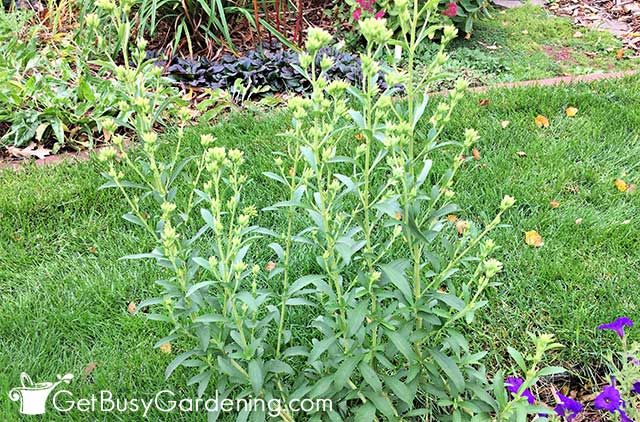
Temperature
Stevia prefers a warm temperature range of 70-85°F (21-29°C) and will suffer at anything below 45°F (7°C).
When temperatures fall below the ideal range, growth slows down and eventually stops. It can survive occasional freezing temps if it’s given adequate protection with mulch or row covers.
You can also overwinter it indoors in a container or as cuttings that you can root and replant the following spring.
Fertilizer
Fertilizer isn’t necessary to grow stevia, but the occasional feeding can invigorate growth and boost your harvest.
Use an all-natural balanced option like compost tea or fish emulsion. Dilute it by half and apply at the base of the plant every two weeks throughout the summer.
Otherwise you can apply slow-release granules at planting time, and then top dress it again in mid-summer. Learn all about how to fertilize herbs here.
Soil
Stevia grows well in loose, loamy, well-drained soil with a pH between 6.7-7.2, which you can test with a probe meter.
Use an organically rich potting soil for containers, or amend your garden bed with well-rotted compost before planting to provide nutrients and improve drainage.
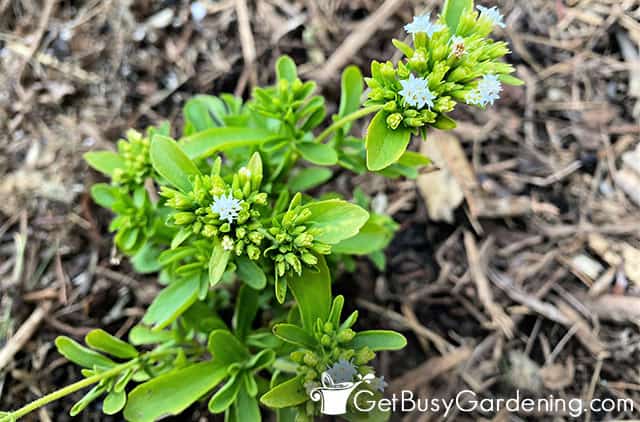
Pruning
Consistent pruning throughout the season is very beneficial to Stevia rebaudiana. It helps create a fuller, bushier plant, strengthens the stems, and delays flowering.
Pinch back the tips by taking the topmost leaves as needed. You can also cut the branches back by up to half 2-3 times through the summer and fall.
Always use sharp shears or precision pruners that are clean and sterile.
Pest Control Tips
Stevia plants are fairly pest resistant. On rare occasions bugs like aphids, whiteflies, thrips, snails, or slugs can become an issue.
Use a sharp blast of water to rid foliage of small bugs, or prune off heavily infested leaves. Hand pick snails and slugs or use Sluggo pellets to help control them.
Natural treatments like neem oil and insecticidal soap are also useful. I make my own by combining 1 teaspoon of gentle liquid soap with 1 liter of water.
Disease Control Tips
Stevia plants are also resistant to most diseases. But they can occasionally be affected by soil-borne leaf spot diseases, root rot, and mold.
Keep plants spaced and pruned enough to provide good air circulation. Always water at the base of the plant to prevent soil from splashing onto the leaves. Avoid overwatering to prevent rot.
Tips For Harvesting Stevia
As soon as your stevia plant is 8” or taller, you can begin picking the leaves. Use micro tip snips or precision pruners that are sharp and sterile to cut leaves or whole branches from the plant.
Take top leaves as needed throughout the season, but never remove more than half the total plant. Pick them in the morning when the sugars are at the highest concentration.
In the fall, many gardeners harvest the entire plant and take cuttings to overwinter for the following year.
Wait until after the weather cools slightly, which intensifies the sweetness. But don’t allow it to flower, the leaves become bitter once it blooms.
Related Post: How To Make Homemade DIY Liquid Stevia Extract
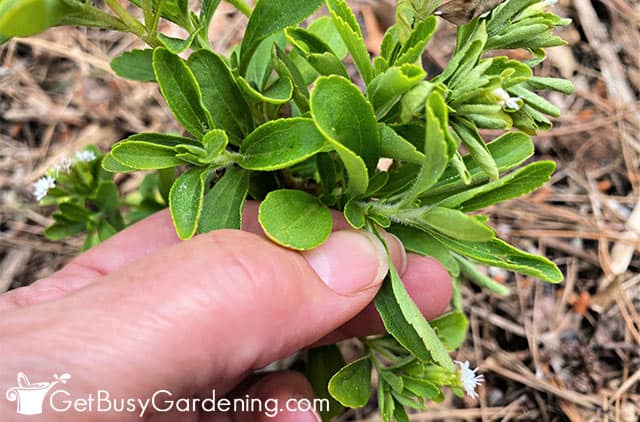
Troubleshooting Common Problems
Stevia is fairly low-maintenance, but no plant is completely problem free. If you run into one of these more common issues, use the troubleshooting tips below to get it back on track.
Yellow Leaves
Yellow leaves on stevia can be caused by poor soil quality, nutrient deficiencies, overwatering, extreme heat, or leaf spot diseases.
Alkaline soils or low nitrogen levels can lead to yellowing foliage. Try testing your soil, and use an acidifier amendment or a high nitrogen fertilizer as needed.
Keep the soil moist, but never water the point of puddling or making it very soggy. A moisture meter probe can help you get it just right.
Temperatures above 85°F (29°C) will lead to yellowing and leaf drop. So provide dappled shade in the afternoon while the temps are high. A shade cloth can help with that.
Stevia Growing Leggy
Legginess is natural for stevia plants left to grow without pruning. It can be aggravated by lack of light, cool temps, or poor soil nutrition.
Prune the tops of the branches every 1-2 months in the summer, and pinch back the tips regularly to encourage bushier, fuller growth.
Provide ample light and fertilizer with a balanced, diluted liquid fertilizer, or side-dress with compost or slow-release granules.
Brown Leaves
Brown leaves on green stevia are usually an indication of drought stress, lack of humidity, or extreme temperatures. It can also be caused by some diseases such as Septoria or Alternaria leaf spot.
Check the soil moisture level. It should be consistently damp and not allowed to dry out completely or for long periods of time.
Temperatures consistently above 85° (29°C) or below 45°F (7°C) can cause the leaves to dry out or die off.
If the browning appears as reddish or yellow ringed spots, you’re dealing with a disease. Remove affected foliage immediately and destroy it. Air circulation and correct watering practices are key to preventing the spread.
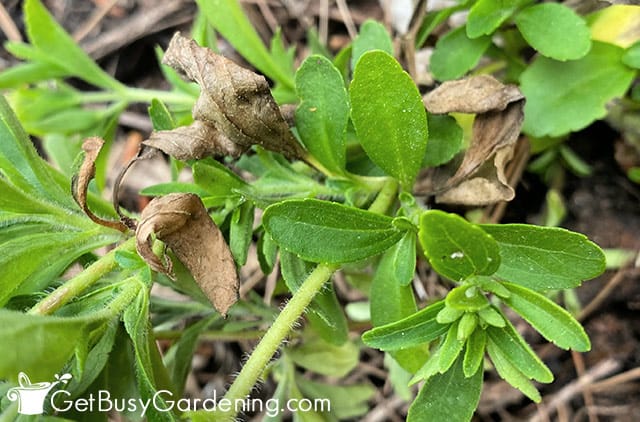
FAQs
Here I’ve answered some of the most commonly asked questions about growing stevia. If yours isn’t listed, please add it to the comments section below.
Can you eat stevia leaves?
Yes, you can eat stevia leaves fresh or dried, or use it to add a natural sweetener to your food. The sweetness of the fresh leaves isn’t as intense as the processed products you can get from the store though.
Is stevia easy or hard to grow?
Stevia is easy to grow once you know how to provide what it needs. Lots of light, warm weather, adequate moisture, and healthy, well-drained soil help make it a low-maintenance and productive addition to your garden.
Does stevia grow back every year?
Stevia can grow back every year in zones 8-11, where the winters are mostly frost free. It can survive occasional freezes, but very cool winters will eventually kill it. Although it does lose its sweetness with age, so many people replant it as an annual every year.
How long does it take to grow stevia?
It doesn’t take very long to grow stevia, with the proper care you can start harvesting about 40-65 days after planting.
Is stevia a perennial or annual?
Stevia is a perennial in warm climates that don’t regularly experience extreme frosts or freezes, like in zones 8-11. But because the plant declines in sweetness each year, it is often grown as an annual instead.
If you’d like to learn how to make the most of your space and get as much homegrown food as possible, then my Vertical Vegetables book is perfect! It will teach you all you need to know, has tons of gorgeous photos, and includes 23 DIY projects you can build for your own garden. Order your copy today!
Learn more about my Vertical Vegetables book here.
More About Herb Gardening
Share your tips for growing stevia in the comments section below.
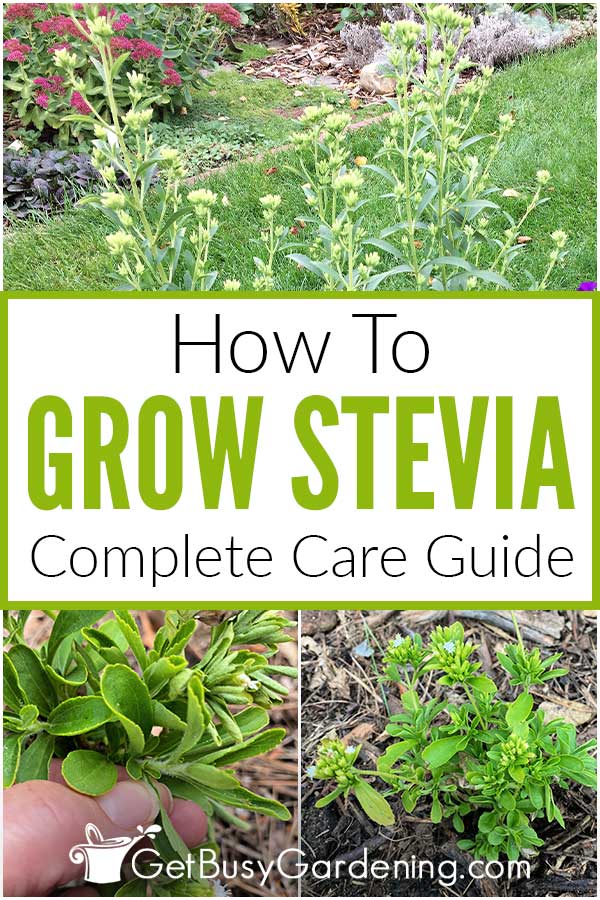
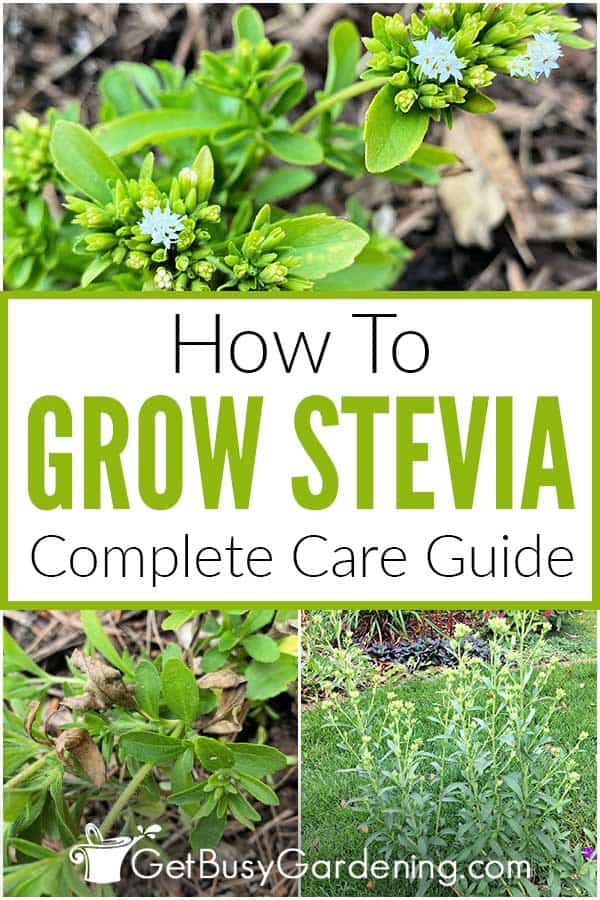
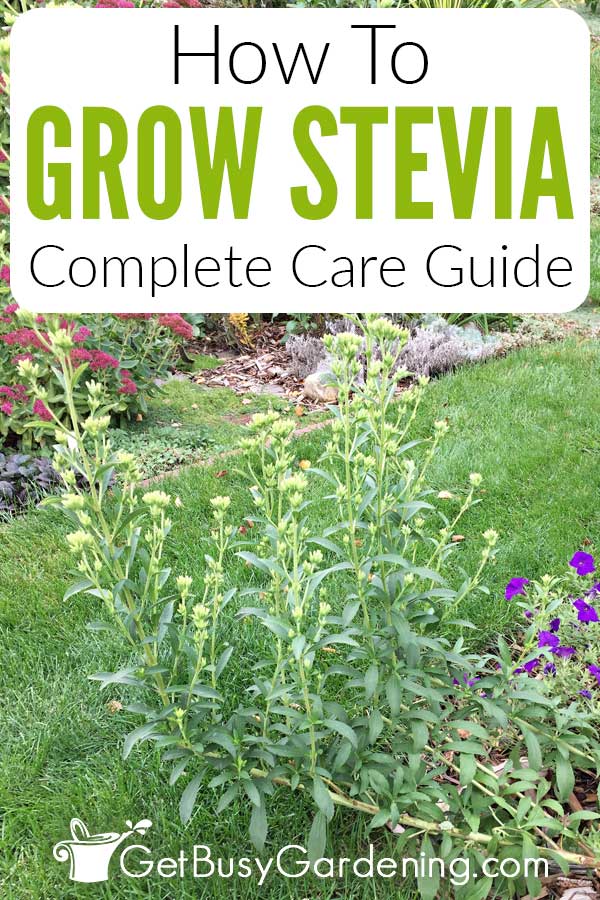


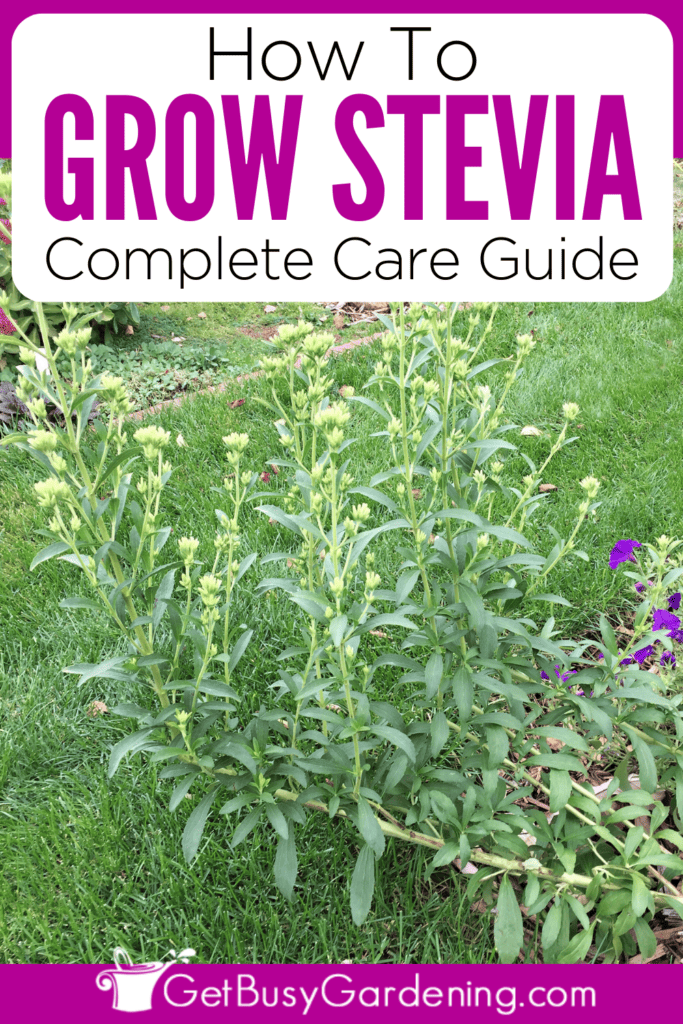

Genno Pewthers says
Leaves on my stevia plant are curling. What can I do
Amy Andrychowicz says
When the leaves on stevia plants start curling, it could be caused by improper watering (too much or too little), low humidity, heat stress, or bugs. First check the soil to make sure it’s not bone dry or wet. It should dry slightly between waterings, and never be soggy or completely dried out. If you live in a very dry/hot climate, then try protecting your plant from shade in the hottest part of the afternoon to ease the heat stress. Also inspect the leaves to make sure they don’t have bugs.